
High-Fidelity Patient Simulator Experiences
High-fidelity patient simulators are life-like manikins that react physiologically as if they were alive. These advanced manikins are used to recreate real-life situations and provide learners with an opportunity to practice and refine clinical skills without the risk of patient harm.
High-fidelity simulations extend beyond the simulator and include the surroundings, equipment, and modes of communication, to help learners suspend disbelief to fully immerse themselves into the experience.
Meet our Simulator Family
-
Adult Patient Simulator: iStan
iStan is a life-like adult manikin whose software and functions are manipulated by operators at a distance. Manikin control from a remote location and out of view of the learners contributes to the realism of the scenario and fosters independence in clinical judgment while learners utilize available resources (equipment, manuals, peers, etc.).
Learners can perform physical examinations on iStan to determine his condition, recognize deterioration, or monitor his improvement. A complete physical examination includes the assessment of vital signs (heart rate, respiratory rate, and blood pressure) and an appraisal of the patient’s head, neck, abdomen, limbs, heart, and lungs. Manikin operators can manipulate all of these parameters to learn the differences between various health conditions and disease states.
In addition, the manikin is equipped with a wireless microphone and programmed with select sounds and phrases enabling him to communicate during a scenario. He can also produce life-like breath sounds, heart sounds, and lung sounds. He has palpable pulses, visual capillary refill, and responsive pupils.
To complement what learners hear, feel and see, iStan’s software provides monitor displays of physiologically appropriate vital signs for learners to view and interpret. The physiologically modeled data can provide ECG output, respiratory rate, blood pressure, oxygen saturation, heart rate, body temperature and more.
This integrated software also comes with factory developed scenarios. Examples include healthy adult, anaphylaxis, pneumothorax, angina with cardiac arrest, anterior myocardial infarction, and COPD exacerbation. Upon request, Simulation Center staff will create scenarios for personalized learning experiences In addition, iStan is programmed with advanced cardiovascular life support (ACLS) megacode scenarios developed by the American Heart Association.
iStan provides invaluable student learning in a safe and supportive environment.
-
Childbirth Simulator: Victoria S2200
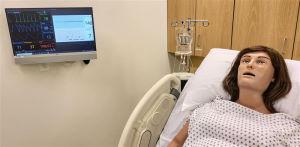 Victoria is an adult female human patient simulator designed to help improve patient safety in women’s health. This simulator runs on Gaumard’s user-friendly software with wireless and tether-less capabilities. Learners at the Richard A. Henson Medical Simulation Center have the opportunity to develop specialized skills to effectively communicate, diagnose, and treat pregnancy complications, high-risk deliveries, postpartum emergencies, and non-gravid scenarios for general nursing care
Victoria is an adult female human patient simulator designed to help improve patient safety in women’s health. This simulator runs on Gaumard’s user-friendly software with wireless and tether-less capabilities. Learners at the Richard A. Henson Medical Simulation Center have the opportunity to develop specialized skills to effectively communicate, diagnose, and treat pregnancy complications, high-risk deliveries, postpartum emergencies, and non-gravid scenarios for general nursing careVictoria can present learners with various heart sounds, breath sounds, palpable pulses, and the ability to secrete fluids and speak in real-time, made possible by an operator with a wireless headset. Learners experience natural patient eye movement, and the eyes can automatically track objects illustrating signs of stress, stroke, head trauma, drug use, nerve impairment, and many other diseases and conditions.
She also has a realistic airway that allows for emergency procedures like endotracheal intubation and can be placed on mechanical ventilation. Victoria is capable of replicating realistic labor and childbirth experiences and common complications that occur before, during, and after birth. She has multiple cervices that allow learners to practice actual pelvic exams. Articulating joints and pelvic tilting provides for a variety of delivery positions and childbirth maneuvers.
A high-fidelity, full-term fetus of realistic size and weight can be positioned in Victoria’s abdominal cavity, where it descends and rotates through the birth canal. The baby has a natural feeling umbilical cord that is attached to a simulated placenta. The baby is equipped with active robotics, which provides visible head movement and is flexible with hip articulation, palpable landmarks, the ability to cry, and multiple respiratory sounds with programmable respiratory rates. After delivery, students can obtain a one- and five-minute APGAR score from the baby.
Learners can utilize actual patient monitors and sensors during their evaluation of Victoria and her unborn baby. This unique capability allows learners to practice setting up and operating equipment just as they would in real-world situations.
The software that runs this simulator allows operators to manipulate the manikin’s physiologic states and conditions from a distant control room. Learners can see the changes simultaneously in the manikin and on the vital signs monitor mounted in the room while the simulation unfolds. A unique feature of Gaumard simulators is the ability to file share images, lab results, or multimedia presentations to the monitor in the room. The manikin comes pre-programmed with many scenarios, but Simulation Center staff can create new scenarios for any learner group.
This state-of-the-science pediatric simulator provides invaluable experiences with common complications and life-threatening but rare situations in a safe and supportive environment.
-
Pediatric Simulator: Hal S2225
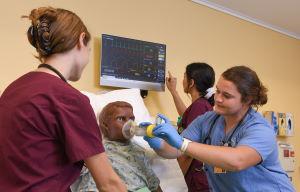 Meet Pediatric HAL®, our newest high-fidelity pediatric manikin capable of simulating natural emotions through dynamic facial expressions, movement, and speech. HAL®, can even cry and produce actual tears. Using HAL’s®, wireless and tether-less capabilities, the diverse learners of the Richard A. Henson Medical Simulation Center develop specialized skills to effectively communicate, diagnose, and treat young patients in a vast array of clinical settings.
Meet Pediatric HAL®, our newest high-fidelity pediatric manikin capable of simulating natural emotions through dynamic facial expressions, movement, and speech. HAL®, can even cry and produce actual tears. Using HAL’s®, wireless and tether-less capabilities, the diverse learners of the Richard A. Henson Medical Simulation Center develop specialized skills to effectively communicate, diagnose, and treat young patients in a vast array of clinical settings.Learners can provide airway support by inserting an endotracheal tube into HAL ®,either orally or nasally. The simulator is capable of differentiating whether or not the ET tube was inserted correctly. HAL®, can also receive respiratory support through a tracheostomy tube. The simulator can simulate central cyanosis, or lack of oxygen in the blood, by turning his cheeks blue. Learners can auscultate upper and lower lung sounds on the anterior and posterior chest and the right and left sides.
Additionally, the new Pediatric HAL®, simulator has palpable carotid, brachial, and radial pulses and heart sounds, including various murmurs. Learners can even obtain accurate glucose testing via a finger stick.
Pediatric HAL will respond to light and have horizontal and vertical tracking capabilities. He has injection sites on his shoulders and thighs and intraosseous access at the tibia. This pediatric manikin can also “talk” through pre-recorded sound clips or wirelessly through an operator headset.
Learners can utilize actual patient monitors and sensors during their evaluation of Pediatric HAL®,. This unique capability allows learners to practice setting up and operating equipment just as they would in real-world situations.
The software that runs this simulator allows operators to manipulate the manikin’s physiologic states and conditions from a distant control room. Learners can see the changes simultaneously in the manikin and on the vital signs monitor mounted in the room while the simulation unfolds. A unique feature of Gaumard simulators is the ability to file share images, lab results, or multimedia presentations to the monitor in the room. The manikin comes pre-programmed with many scenarios, but Simulation Center staff can create new scenarios for any learner group.
This manikin also has an important place in teaching CPR. Learners can perform chest compressions on the manikin, and the software will evaluate the quality of their efforts. The manikin has lung compliance refined to deliver chest rise with ventilations measured and logged. The simulator allows defibrillation, cardioversion, and cardiac pacing with real energy. This state-of-the-science pediatric simulator provides invaluable experiences with common complications and life-threatening but rare situations in a safe and supportive environment.
-
Pediatric Simulator: Hal S3005
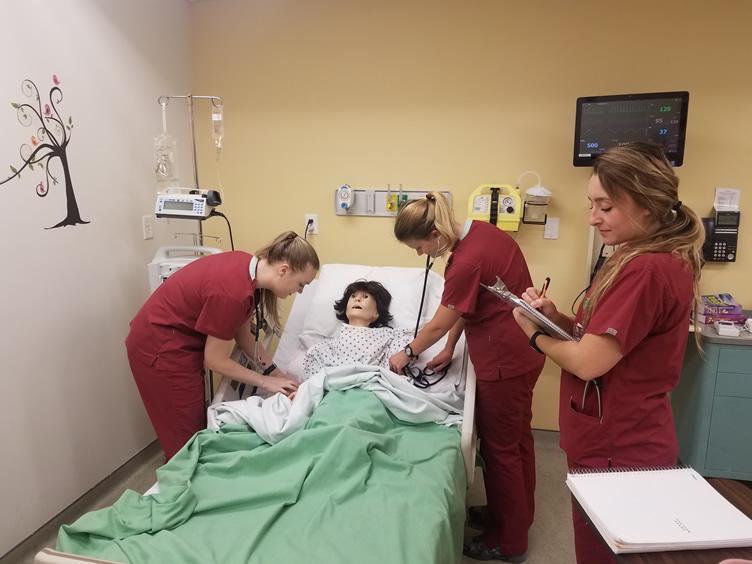 This wireless and tetherless high-fidelity five year old pediatric simulator HAL® S3005 provides experiences in caring for children. Learners have the ability to orally or nasally intubate him and the manikin can simulate right mainstem intubation or gastric inflation if performed incorrectly. He has sounds in his upper airways, lungs, heart, and bowels as well as carotid, brachial, and radial pulses. His pupils will respond to light, just as a real patient’s would. He also has injection sites on his shoulders and thighs and intraosseous access at the tibia. The simulator can simulate central cyanosis, or lack of oxygen in the blood, by turning his cheeks blue. This pediatric manikin can also “talk” through pre-recorded vocal sound clips or wirelessly through an operator headset.
This wireless and tetherless high-fidelity five year old pediatric simulator HAL® S3005 provides experiences in caring for children. Learners have the ability to orally or nasally intubate him and the manikin can simulate right mainstem intubation or gastric inflation if performed incorrectly. He has sounds in his upper airways, lungs, heart, and bowels as well as carotid, brachial, and radial pulses. His pupils will respond to light, just as a real patient’s would. He also has injection sites on his shoulders and thighs and intraosseous access at the tibia. The simulator can simulate central cyanosis, or lack of oxygen in the blood, by turning his cheeks blue. This pediatric manikin can also “talk” through pre-recorded vocal sound clips or wirelessly through an operator headset.The software that runs this simulator allows operators to manipulate the manikin’s physiologic states and conditions from a distant control room. Learners are able to see the changes simultaneously in the manikin and on the vital signs monitor that is mounted in the room while the simulation unfolds. A unique feature of Gaumard simulators is the ability to file share images, lab results, or multimedia presentations to the monitor in the room. The manikin comes pre-programmed with many scenarios, but Simulation Center staff also have the ability to create their own.
This manikin also has an important place in teaching CPR. Learners can perform chest compressions on the manikin, and the software will evaluate the quality of their efforts. The manikin has lung compliance refined to deliver chest rise when ventilating at 20 cm H 2O with ventilations measured and logged. The simulator allows defibrillation, cardioversion, and cardiac pacing with real energy.
This state-of-the-science, pediatric simulator provides invaluable experiences with common complications, and life-threatening but rare situations in a safe and friendly environment.
The addition of Pediatric Hal to our growing “family” of simulators was made possible through a grant from the Maryland Clinical Simulation Resource Consortium (MCSRC), a statewide funding initiative, which is part of the Health Services Cost Review Commission (HSCRC) Nurse Support Program II (NSP II).
-
Newborn Simulator: Super Tory
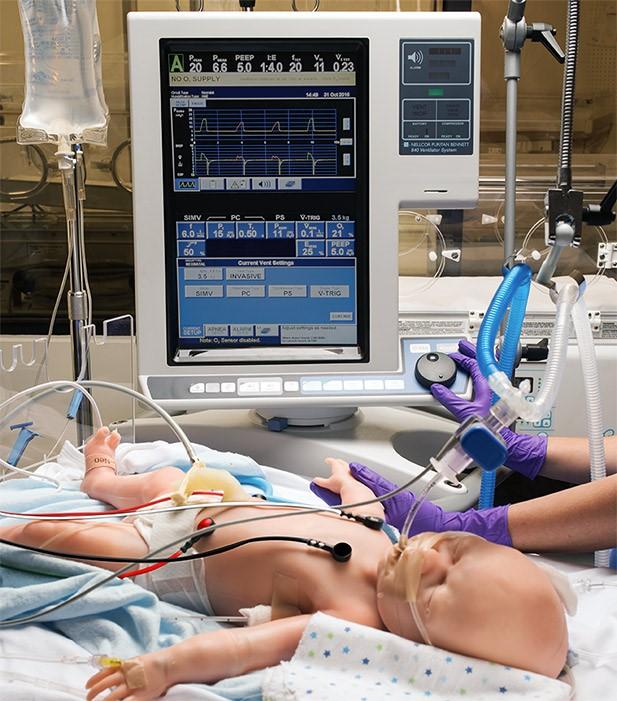 Salisbury University was the recipient of a 2018 Maryland Clinical Simulation Resource Consortium (MCSRC) Equipment & Materials Award in the amount of $61,678.00 to support the acquisition of a new high-fidelity newborn manikin. The goals of the MCSRC are to promote the use of simulation in nursing education in Maryland, establish simulation quality guidelines that will promote patient safety, and provide resources to maintain simulation equipment for nursing programs.
Salisbury University was the recipient of a 2018 Maryland Clinical Simulation Resource Consortium (MCSRC) Equipment & Materials Award in the amount of $61,678.00 to support the acquisition of a new high-fidelity newborn manikin. The goals of the MCSRC are to promote the use of simulation in nursing education in Maryland, establish simulation quality guidelines that will promote patient safety, and provide resources to maintain simulation equipment for nursing programs.The Medical Simulation Center proudly welcomes Super Tory, a high-fidelity newborn patient simulator, manufactured by Gaumard Scientific. Super Tory is a newborn simulator that gives learners the opportunity to rehearse real-life health care scenarios with confidence and ease. Baby Hal, Super Tory’s predecessor has given our learners many years of life-like practice before heading into the real-world, clinical setting. Super Tory is a wireless and tetherless manikin with cutting-edge anatomical and physiological characteristics that allow for a more realistic experience. This manikin has programmable heart and lung sounds, detectable pulses and blood pressure reading capabilities. Super Tory features realistic skin and programmable movements including seizures, limb flexion and extension, eyes that open and close, and gasping and clenching actions of the mouth. This simulator also exhibits an anatomically accurate airway for intubation and permits SpO 2 and EtCO 2 monitoring with real sensors. The new respiratory system design is capable of accepting mechanical ventilation support while adjusting pulmonary function. These advanced features allow for a physiologically accurate progression through respiratory disease via treatment, weaning, and rehabilitation.
Along with the ability to accept real energy with defibrillation, cardioversion, and cardiac pacing, Super Tory also features eCPR TM real-time quality feedback and reporting to assist with CPR practice and mastery.
-
Gaumard Scientific Newborn Simulator: Hal S3010
Baby Hal is a 5 ½ pound newborn wireless high fidelity simulator with a very extensive list of features. He has independent chest rise with lung, breathing, and airway sounds. He can be orally or nasally intubated. Additionally, Baby Hal has heart sounds and palpable pulses. He has the ability to become cyanotic and visibly shake. It is also possible to insert an intraosseous needle in the tibia for the infusion of fluids, blood, or drugs The baby’s software comes with scenarios such as healthy baby, asphyxia, pneumothorax, transient tachypnea, meconium aspiration syndrome, and mild respiratory distress syndrome. Simulation Center staff also have the ability to create and save unique scenarios for personalized learning experiences. Monitor displays include ECG, respiratory rate, blood pressure, oxygen saturation, and heart rate.
-
ASL 5000 Breathing Simulator
The ASL5000TM provides ventilator training and ventilation management by simulating almost any breathing profile imaginable – from newborn through adult. Using the ASL5000TM, real life respiratory scenarios can be created to meet the full spectrum of challenges including coughs, apnea, active exhalation, snoring and more. A unique feature of the ASL5000TM is its ability to breathe spontaneously while being ventilated, allowing learners to adjust ventilator settings and respond to patient parameters in real time to understand effective ventilator therapy. This simulator also has the potential to provide learners with hands-on experiences managing rare, catastrophic events, all within a safe environment.
This simulator has several unique features including the ability to program the software for parameter changes to facilitate the development of standardized scenarios for a variety of learners. The interactive control panel, however, facilitates breath by breath control with the capability to make on-the-fly changes in patient parameters as well. More than 90 patient parameters are recorded during simulation for data analysis and debriefing purposes. This allows learners to evaluate the performance of the ventilator, evaluate the performance of respiratory therapy devices (e.g. CPAP, aerosol drug delivery devices), and evaluate their mode of ventilation selection.
This simulator is the only neonatal spontaneously breathing simulator worldwide and it is available for use right here at SU!
Other non-health care related applications include use by learners enrolled in Differential Equations or Calculus I for Biology and Medicine at Salisbury University who calculate models and graph three physiological respiratory physiological parameters: the lung’s volume across time, the gas flow of air into/out of the lungs, and the pressure at within the airway required to maintain proper ventilation during inspiration and expiration. While at the simulation center in conjunction with a respiratory care practitioner, they have the opportunity to test their calculations on the ASL5000TM. This activity bridges the gap between a mathematician’s understanding of the equations and complex mathematical models underlying the graphs and a respiratory therapist’s understanding of the physiological implications of, and recommended treatment for, a patient in experiencing respiratory failure.
-
Anatomage Virtual Dissection Table
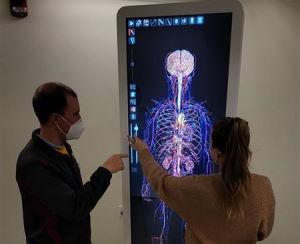 The Sim Center’s Virtual Dissection Lab offers an Anatomage™ Table, the most technologically advanced, three-dimensional visualization system to conduct virtual dissection. High-definition images from human and animal cadavers are presented on an interactive, life-sized touch screen and manipulated by learners to master important concepts of normal and abnormal anatomy and physiology
The Sim Center’s Virtual Dissection Lab offers an Anatomage™ Table, the most technologically advanced, three-dimensional visualization system to conduct virtual dissection. High-definition images from human and animal cadavers are presented on an interactive, life-sized touch screen and manipulated by learners to master important concepts of normal and abnormal anatomy and physiology -
Mixed Reality Enhanced Learning System: Obstetric MR™
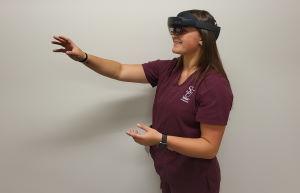 Obstetric MR™ is a next-generation mixed reality training solution that works with Victoria, an adult female human patient simulator. The Obstetric MR™ is designed to help learners bridge the gap between theory and practice in a more cohesive way through holographic visualization. By synchronizing holograms with the physical world, Obstetric MR™ allows learners to see inside Victoria and observe the dynamic physiology underlying difficult deliveries to promote deeper learning. Obstetric MR™ helps learners understand clinical cause and effect through hands-on practice. Simulation Center staff can adjust the learning mode for all participants and send messages directly to the headset enhancing the simulation experience.
Obstetric MR™ is a next-generation mixed reality training solution that works with Victoria, an adult female human patient simulator. The Obstetric MR™ is designed to help learners bridge the gap between theory and practice in a more cohesive way through holographic visualization. By synchronizing holograms with the physical world, Obstetric MR™ allows learners to see inside Victoria and observe the dynamic physiology underlying difficult deliveries to promote deeper learning. Obstetric MR™ helps learners understand clinical cause and effect through hands-on practice. Simulation Center staff can adjust the learning mode for all participants and send messages directly to the headset enhancing the simulation experience.